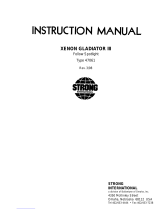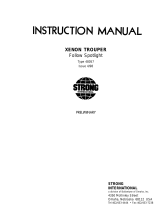
Requirements
6. Lamp Alignment
Remove the lamp compartment cover to
gain access to the Lamphouse.
Loosen the X & Y axis locking screws at the
rear bottom and rear left of the Lamphouse.
1
2
On the Touchpanel or Communicator,
navigate to the “Control Tab,” and then to
the "Service" page.
3
Locate the "Current Light Output" box,
and note the window labeled "Footlambert
Measured." The value as listed is used to
calibrate your lamp to the lamp reflector.
4
On the Lamphouse, adjust the X axis point
until the value reaches its peak. As you
adjust, if the value decreases, turn the
adjustment point in the other direction until
the number peaks — and then decreases.
5
• Lamp alignment requires a Touchpanel or a PC with the Barco Communicator Software
installed on it.
• Prior to starting the lamp alignment procedure, always allow the lamp to warm up and stabilize
for 5 - 10 minutes.
Procedure
When the value peaks and starts to
decrease, stop the adjustment for that point.
6
Once all axis points are adjusted to the
maximum value, alignment is complete.
Tighten the X & Y locking screws to
secure the bulb in place.
7
9
Repeat steps 5 and 6 for the Y axis.
8
Repeat steps 5 and 6 for the Z axis.
5
7
8
Procedure
Warning
• DP-1500, DP-2000 and DP-3000 projectors are not shipped with a lamp installed.
The xenon bulb is shipped separately and must be installed by a qualified service
technician.
• Xenon compact arc lamps are highly pressurized and explosive. Whenever you
dismantle a lamphouse with a xenon bulb installed, authorized protective clothing
must be worn!
5. Lamp Installation
For a detailed bulb installation procedure, refer
to page 33 of the Barco Projector Installation
Manual, or view the Lamp Installation Video.
1
Procedure
Lens Shift: Use the four “Lens
Shift” keys (or the “Lens” section
on the Touchpanel) to move the
image up, down, left or right.
1
Zoom: Use the “Zoom” keys on the
keypad (or use the Touchpanel) to
increase or decrease image size.
2
Focus: Use the “Focus” keys on the
keypad (or use the Touchpanel) to adjust
the main overall focus of the image.
3
Procedure
4. Lens Installation
7. Lens Alignment
Remove the foam rubber that is inserted in
the lens opening.
1
Remove the lens caps (or the lens covers).
Move the lens locking lever to the
unlocked position (left).
2
3
Insert the lens, and ensure that it is not
tilted or angled inside the lens holder.
5
Move the lens locking lever to the locked
position (right).
4
Ensure that the lens is locked in position,
and that there is no movement when you
attempt to wiggle the lens.
6
7
Align the plug socket on the lens with the
connector on the projector.
Turn on the Power switch on
the side of the projector, then
strike the lamp using the Lamp
button on the keypad.
Press Test Pattern until the
“DCI_XYZ_White_12bit” test
pattern appears.
Align the image to fill the screen masking
using the following functions:
5
1 2
4
3
5
4
2








